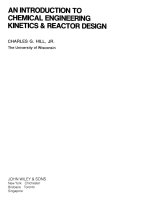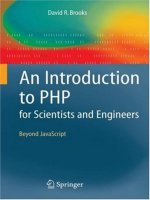An Introduction to Language Policy Theory and Method.
Bạn đang xem bản rút gọn của tài liệu. Xem và tải ngay bản đầy đủ của tài liệu tại đây (431.43 KB, 3 trang )
An Introduction to Language Policy: Theory and Method.
Thomas Ricento (Ed.). Oxford: Blackwell, 2006. Pp. xii + 371.
Ⅲ This book provides an excellent introduction to a wide range of theoretical and methodological perspectives on language policy (LP) that are not
usually found in language policy books. In addition, it is an easy-to-read,
well-organized treatment of many of the issues associated with language,
society, and social change. As a comprehensive collection of important
articles concerning LP theories, methods, and issues written by wellrecognized LP researchers, this book achieves its goal as “a thorough
introduction to the principal theories and methods which are used in
current research in language policy” (p. x).
The book consists of 19 chapters, grouped into three main sections. The
first section, “Theoretical Perspectives in Language Policy,” is devoted to
the discussion of influential theories proposed to explain the role of language and language policies in the shaping of societies around the world. In
the overview chapter, Ricento mentions that “language policies are made,
or are implicitly acknowledged and practiced, in all societal domains” (p.
19). The understanding of how the existing LP theories interact with practices in different areas of society will help generate new lines of research
and methods. Recognizing LP research as both a multidisciplinary and an
interdisciplinary activity, Ricento proposes that “conceptual and methodological tools borrowed from various disciplines need to be appropriately
integrated and applied to real-world problems and challenges involving
languages, which by definition, are embedded in all aspects of society and
social life” (p. 9). Hornberger (chapter 2) provides a historical overview of
the development of language policy and planning, and proposes an integrative language policy and planning framework based on previous works
of scholars. The remaining chapters in this section concern five LP theories. Critical theory (rooted in critical applied linguistics) by Tollefson
(chapter 3) applies two key assumptions to LP: structural categories (i.e.,
class, race, and gender) and a critical examination of epistemology and
research methodology in relation to ethical standards and political commitments to social justice. Pennycook (chapter 4), although accepting that
it is hard to see the relationship between LP and postmodernism, proposes
that a postmodern approach may “suggest a rethinking of our social, economic, and political categories in favor of a more localized understanding
of modes in governmentality” (p. 71). Similarly, Grin (chapter 5) mentions
that an economic approach can help people evaluate different avenues
and make wiser choices. Schmidt (chapter 6) asserts that a political viewpoint is a usual approach providing “insights and reasoned interpretations
of what is at stake in political conflicts over language policy” (p. 107). In the
final chapter in this section, Schiffman (chapter 7) views language policy
380
TESOL QUARTERLY
(i.e., decision making about language at a top-down level) as interconnected to linguistic culture (i.e., every cultural thing that speakers bring
with them when dealing with language or de facto).
Turning to methods in researching and evaluating language policy, the
second section, “Methodological Perspectives in Language Policy,” discusses how theories and methods within disciplines have contributed to a
better understanding of issues addressed in subfields of language policy.
In an overview, Ricento calls for the “use of multiple methods in exploring
important questions about language status, language identity, language
use, and other topics that fall within the purview of research” (p. 129).
Wiley (chapter 8) explicitly states that through careful and cautious investigation of history, language policy formation can be better informed.
Canagarajah (chapter 9) proposes that ethnographic methods can help
assess the effectiveness of language policies as well as the tension created
by policies. Wodak (chapter 10) suggests that discourse analysis can shed
light on the ambivalence and the ideological dilemmas that need to be
taken into careful consideration when language policies are debated.
Cartwright (chapter 11) shows how geolinguistic analysis can provide
deeper insights into the development of current patterns in human contact and interaction among different cultural groups, and how this information can be used to inform policy-makers’ decisions. In the last chapter,
Baker (chapter 12) discusses a psychosociological approach to analysis,
and discusses how this approach, with both qualitative and quantitative
methods, can contribute to making language policy.
The third section of the book, “Topical Areas in Language Policy,”
describes how language policy affects all aspects of social identity and
social change. In an overview, Ricento asserts that people define their identity and others’ through languages, and just one or a few languages are
selected to be national language(s) in a multilingual community. This situation unfortunately often leads to conflicts. Based on a Tanzanian sample
that shows the ineffectiveness of singular projections of language on national
identity, Blommaert (chapter 13) proposes that language policy should be
considered a “niched” activity (p. 249), which is interconnected with other
factors. May (chapter 14) discusses LP and minorities’ rights, stating that it
is crucial to adopt a wider sociohistorical, sociocultural, and sociopolitical
analysis to understand and promote the right of minority groups’ languages.
Skutnabb-Kangas (chapter 15) insists that language rights are vital because
they are the basis of human rights. Similarly, Paulston and Heidemann
(chapter 16) discuss human rights in terms of education policies for minorities. They advance that “a language policy is never simply and only about
language” (p. 305); it is related to power and inequity. Unlike other chapters, Joshua Fishman’s chapter (chapter 17) concerns language shift. Policy
makers should be made aware of consequences of primary policies on other
aspects of society that result in language decline, language death, and
REVIEWS
381
language shift. Reagan (chapter 18) calls for the promotion of an explicit
and implicit agenda in order to increase sign language users’ rights. In the
final chapter, Phillipson (chapter 19) discusses the role of English as a lingual franca, or linguistic imperialism, in globalization. English is perceived
as a threat to other languages and causes tensions at international and
national levels of society, as well as between top-down and bottom-up levels.
Overall, this book provides a comprehensive introduction to LP theories and methods. It offers an excellent overview to both well-established
and new approaches in the field (e.g., geolinguistics), together with key
concepts and samples of studies. In addition, it exposes the reader to
controversial issues and domains that are affected by LP. This is vital
because a policy must address both linguistic and nonlinguistic elements
in society, because studying only one aspect and ignoring others will “provide a very incomplete and biased view” (Spolsky, 2004, p. 40). The
selected annotated bibliographies offer a useful starting point for further
reading and research in the LP field. The usefulness of the discussion
questions at the end of each chapter, however, may be less apparent.
Although they may help the reader to understand the content, they do
not lead to higher thought or ideas for further research.
Given the lack of LP books containing a combination of explicit discussions of various LP theories, methods, and major issues, this book provides
a comprehensive overview. It is useful for novice LP researchers, and it is
suitable for an introductory course in language planning and policy at the
graduate level. Also, experienced researchers in language policy, education, applied linguistics, and related fields will appreciate the in-depth
and thorough discussions of the wide range of issues presented.
REFERENCE
Spolsky, B. (2004). Language policy: Keys topics in sociolinguistics. Cambridge: Cambridge
University Press.
ANGKANA TONGPOON
Khon Kaen University
Khon Kaen, Thailand
Adult Biliteracy: Sociocultural and Programmatic Responses.
Klaudia M. Rivera and Ana Huerta-Macías (Eds.). New York: Erlbaum,
2008. Pp. xiv + 225.
Ⅲ What is the relationship between biliteracy and TESOL studies? What
does research tell us about the role of the first language in acquiring
382
TESOL QUARTERLY




![an introduction to conformal field theory [jnl article] - m. gaberdiel](https://media.store123doc.com/images/document/14/rc/yp/medium_r4fuKTjzPm.jpg)




